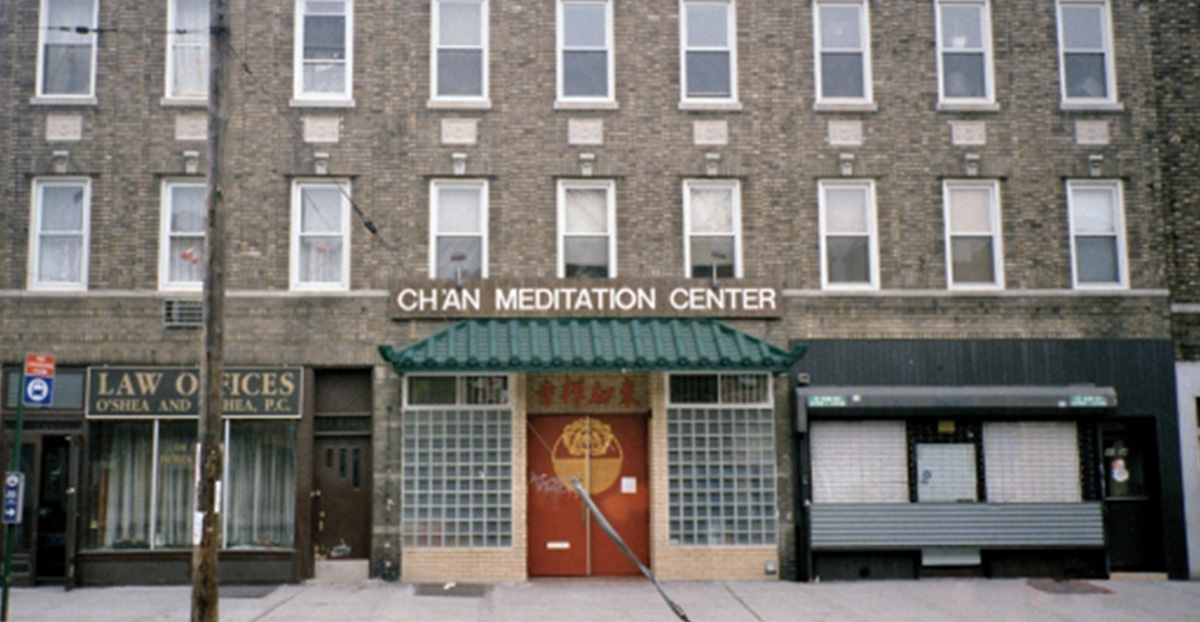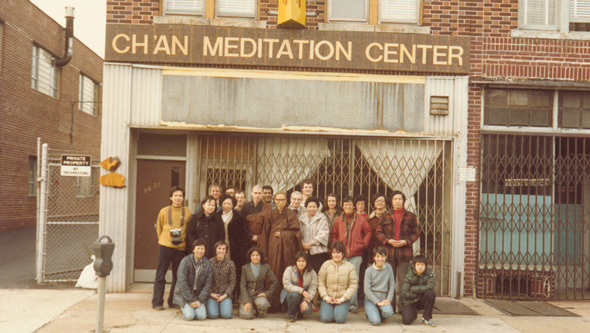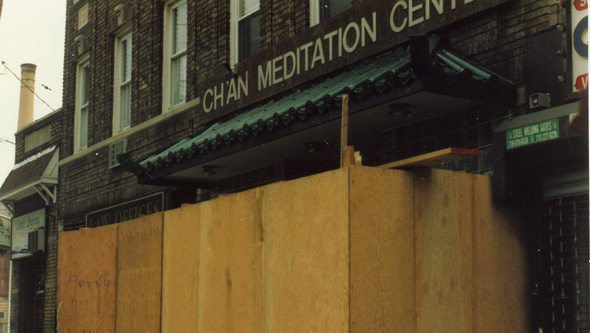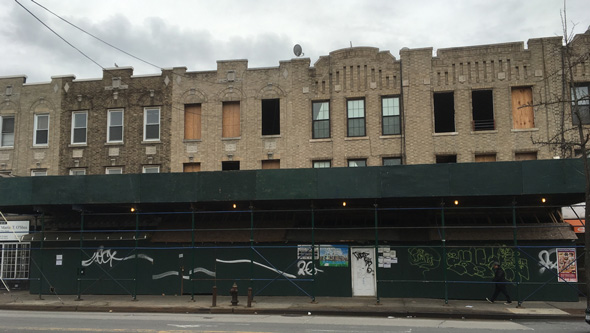was founded by the late Chan Master Sheng Yen in 1977
with the purpose of bringing Chinese Chan[Zen] Buddhism to the Western world.
CMC is open year round. The organization runs various programs to teach the doctrine and practice
of Chan Buddhism, to promote the purification of human life, and to preserve traditional Chinese culture.
We also publish the quarterly Chan Magazine in English, and are associated with Dharma Drum Publications,
which has published a series of books by Master Sheng Yen, and Dharma Drum Retreat Center in Pine Bush, NY.
The Center is also a small monastery where bhikshus and bhikshunis (fully ordained monks and nuns) live
and practice the traditional precepts. Among the activities offered at CMC are:
meditation classes/retreats, Dharma classes, Tai-Chi classes,
Sunday Dharma talks and Buddhist services, Monday evening chanting practice,
and Tuesday evening meditation practice.
We welcome all those interested in meditation and the study and practice of Buddhism,
regardless of background, age, religion or ethnic origin.


that began in May 1976 at the Temple of Enlightenment in the Bronx, New York.
The Buddhist Association of the United States had invited Chan Master Sheng Yen to come to the U.S. to spread the Buddha Dharma; his first class consisted of four students. They met for fourteen weeks, learning a series of meditation methods. Within just two years, more than 200 students hadlearned from Master Sheng Yen.
In May 1977, he held the first seven-day intensive Chan retreat on Long Island. Another seven-day retreat was held in June 1978, followed by two more in April and May 1979. It was soon after the first retreat that the group published its first issue of Chan Magazine. Master Sheng Yen continued to teach his students in the Bronx and at Columbia University.
In 1978, it was decided that the time was right for the group to have a place of its own dedicated to the practice of Chan meditation. But it was just at this time that Master Sheng Yen had to return to Taiwan— his teacher, Master Dongchu, had passed away, leaving him in charge of the Nung Chan Monastery. His responsibilities delayed the establishment of the Center in New York, but ended up establishing the pattern that would continue for the next three decades: each year he would spend six months in the States and six months in Taiwan.

in Elmhurst, Queens.
Over many months, the group waited for the tenants’ leases to expire before the entire building was empty. Then repairs and renovations were carried out by both members and professionals. The first floor (formerly a machine shop) became the meditation hall. Master Sheng Yen held Beginner‘s meditation classes on Saturdays and gave lectures on Sundays. The first intensive retreats were held at the Center in the spring and summer of 1980.
The Chan Meditation Center(CMC) celebrated its official opening on May 10, 1981, in conjunction with the Buddha’s Birthday. A board of trustees was created and officers were appointed. The five-year goals established at the time were: to establish a routine of ceremonies, to hold 4-6 retreats a year, to maintain a schedule of lectures and classes, to hold an annual membership meeting, and to establish a publishing house. Not only were the goals realized, but the Center’s attendance increased; membership grew each year, and the lectures, retreats, and special events drew crowds well beyond the capacity of the space. In fact, by 1984, the maximum number of retreat participants, 24, had been reached. When long-term practitioners wanted to stay longer, there was little room. The library was bulging with books and tapes. Another location was clearly needed.

and the potential of the Chan Center.
Renovations started immediately. At 90-56 Corona Avenue, the former five & dime’s main floor became the Chan Hall, and the upper-story apartments were turned into a meditation room, monks’ quarters, and a library. The Chan Hall allowed for 40 retreat participants, and it provided space for the huge crowds that attended the Buddha’s Birthday and Chinese New Year celebrations, and Master Sheng Yen’s lectures and classes. “Even the Buddha and Bodhisattva statues look happy in their new home,” declared Chan Newsletter No. 62.
On May 22, 1988 a triple celebration of the Buddha’s Birthday, the Tenth Anniversary of the CMC and the and the Inauguration of the new facility took place with over 500 guests in attendance, one of whom commented, “The new Center is getting too small!” And indeed, in no time, the Center did become small. What had felt like a lot of room for retreats soon became tight. It didn’t matter. Participants were open-minded and grateful for Master Sheng Yen’s guidance and teachings. The noise was a problem, however. The Elmhurst Avenue bus stopped right at the front door, and retreatants meditated to the sounds of commuters talking, boom boxes playing, brakes screeching, police sirens racing by, and of course the ubiquitous car alarms.
Master Sheng Yen often said that a true practitioner could practice even in the middle of Times Square. Yet, for practical purposes, in 1994 monastics and volunteers started to search for a quiet, more natural retreat setting. In 1997, a former summer camp was purchased in Pine Bush, New York, and the Dharma Drum Retreat Center was established as the organization’s primary facility for intensive practice, with the Chan Meditation Center maintaining its role as an educational and community center, monastery, and home of Dharma Drum Publications.
Despite a growing schedule of international obligations—the construction of a major monastery, etreat rcenter and Buddhist university in Taiwan, co-chairmanship of the World Council of Religious Leaders, retreats in Russia, Poland, the U.K., Mexico and elsewhere—Master Sheng Yen continued to spend six months of each year in New York, leading four major retreats, teaching Dharma classes, and establishing a Dharma teachers training program, until 2006, when illness made it impossible for him to travel.
Master Sheng Yen passed away in February 2009, leaving behind a robust organization to continue his work of spreading the Dharma. The Chan Meditation Center, run by a spirited corps of resident nuns, continues to be its administrative center, with its full schedule of classes, Buddhist ceremonies and community-oriented cultural events. Senior teachers from among Master Sheng Yen’s Dharma heirs, both Chinese and Western, lead an enhanced schedule of Chan retreats at the Dharma Drum Retreat Center, and continue the work of training a new generation of Dharma students and teachers. Our beloved teacher is gone, but the power of his compassionate vows remains in our hearts, and through the Chan Meditation Center founded by him, his work continues.

Chan Master Sheng Yen passed away on February 3, 2009 in Taiwan, a great loss for his sangha community and lay disciples. To continue his mission to spread the Mahayana and Chan Buddhism and the concept of Spiritual Environmentalism in the West, his sangha community embarked on the Chan Meditation Center Expansion Project by purchasing three adjacent buildings between 2010 and 2013.
Chan Master Sheng Yen first spoke about Spiritual Environmentalism at the United Nations Headquarter in New York City in 2000. Since then, he had traveled around the world to spread this vision and had received very positive feedback. Meanwhile, Chan Buddhism has begun to enter the cultural mainstream in the US and Europe. As such, Chan Meditation Center - ideally located in New York City, one of the world’s major economic, cultural, and artistic hubs - is at the right spot, front and center, to play a pivotal role in promoting Chan Buddhism and nurturing future Chan leaders. With this tasks at hand, the Chan Meditation Center Expansion Project is ever more pressing and vital.
